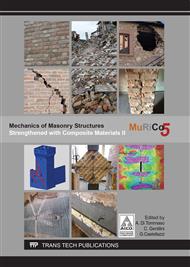p.204
p.212
p.220
p.226
p.234
p.242
p.250
p.258
p.266
Simple Numerical Homogenization Model for FRCM Reinforced Masonry Panels Subjected to Out-of-Plane Loads
Abstract:
The paper deals with the analysis of FRCM reinforced masonry panels in simple bending by means of a two-step homogenization approach. In the first step, homogenization is performed on unreinforced masonry through a straightforward procedure already validated for in-plane loaded FRCM reinforced panels, where the elementary cell is discretized by means of 24 CST elastic elements (bricks) and joints are reduced to interfaces with holonomic softening behavior. Out-of-plane homogenized quantities (moment-curvature relationships) are then obtained by simple on-thickness integration. At a structural level (step two), masonry is modeled with rigid elements and homogenized torsional and bending springs, whereas FRCM by two noded trusses with equivalent mechanical properties evaluated on the base of experimental data available. The implementation is handled within the commercial FE software Abaqus. As a matter of fact, the Concrete Damage Plasticity Model (CDP) already implemented into the code allows taking into account the progressive change of stiffness of brittle supports when subjected to alternate cracking-crushing mechanisms, as well as to properly deal with the cyclic behavior. The validation of the procedure is conducted against a series of full scale masonry walls tested by Nanni and co-workers at the University of Miami. A tri-dimensional heterogeneous micro-modeling technique is also used for both unreinforced and FRCM strengthened panels to further validate the homogenization model proposed. The discretization adopted is adjusted in order to allow the presence of two eight-noded FEs along the mortar joint thickness. FRCM is modeled by means of truss elements whose mechanical properties are calibrated to reproduce the behavior of the textile net embedded into the cementitious matrix. The elastic and inelastic mechanical parameters of all the materials involved into the numerical analyses have been calibrated in agreement with laboratory tests, when available. Pros and cons of the two numerical strategies are discussed mostly with respect to the accuracy of the outcomes in terms of global behavior of the panels and damage mechanisms, as well as with respect to the computational effort required by the two approaches to complete the analyses.
Info:
Periodical:
Pages:
234-241
Citation:
Online since:
July 2017
Authors:
Price:
Сopyright:
© 2017 Trans Tech Publications Ltd. All Rights Reserved
Share:
Citation:


